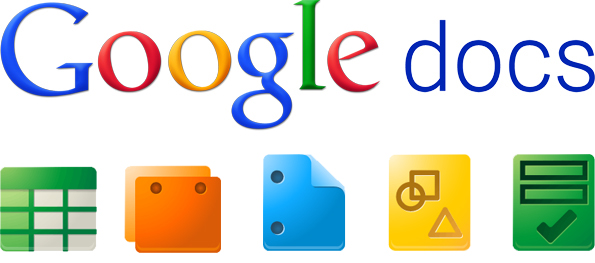1.Microsoft Office
![]()
2.google document

https://en.wikipedia.org/wiki/Google_Docs,_Sheets_and_Slides,_Sheets_and_Slides
3.Zoho office
![]()
4.libreoffice

LibreOffice is a free and powerful office suite, and a successor to OpenOffice.org (commonly known as OpenOffice).
Its clean interface and feature-rich tools help you unleash your creativity and enhance your productivity.
5.openoffice

Apache OpenOffice is the leading open-source office software suite for word processing, spreadsheets, presentations, graphics, databases and more. It is available in many languages and works on all common computers. It stores all your data in an international open standard format and can also read and write files from other common office software packages.
online office platforms in China mainland.
6.WPS office

https://drive.wps.cn/ 或者https://docs.wps.cn
WPS Office is available on multiple platforms, including Windows, macOS, Linux, Android, and iOS. You can work anytime and anywhere on your mobile phone or computer. Work-study-life balance is no longer a far-fetched dream but at your fingertips.
7.tengxun document
![]()
8.dingtalk document
![]()
9.feishu document
![]()
10. Pandoc支持多种格式文本之间的转换
![]()
About pandoc
If you need to convert files from one markup format into another, pandoc is your swiss-army knife. Pandoc can convert between the following formats:
(← = conversion from; → = conversion to; ↔︎ = conversion from and to)
- Lightweight markup formats
-
↔︎ Markdown (including CommonMark and GitHub-flavored Markdown)
↔︎ reStructuredText
→ AsciiDoc
↔︎ Emacs Org-Mode
↔︎ Emacs Muse
↔︎ Textile
→ Markua
← txt2tags - HTML formats
-
↔︎ (X)HTML 4
↔︎ HTML5 - Ebooks
-
↔︎ EPUB version 2 or 3
↔︎ FictionBook2 - Documentation formats
- Roff formats
- TeX formats
- XML formats
-
↔︎ DocBook version 4 or 5
↔︎ JATS
→ TEI Simple
→ OpenDocument XML - Outline formats
-
↔︎ OPML
- Bibliography formats
-
↔︎ BibTeX
↔︎ BibLaTeX
↔︎ CSL JSON
↔︎ CSL YAML
← RIS
← EndNote XML
- Word processor formats
-
↔︎ Microsoft Word docx
↔︎ Rich Text Format RTF
↔︎ OpenOffice/LibreOffice ODT - Interactive notebook formats
-
↔︎ Jupyter notebook (ipynb)
- Page layout formats
- Wiki markup formats
-
↔︎ MediaWiki markup
↔︎ DokuWiki markup
← TikiWiki markup
← TWiki markup
← Vimwiki markup
→ XWiki markup
→ ZimWiki markup
↔︎ Jira wiki markup
← Creole - Slide show formats
-
→ LaTeX Beamer
→ Microsoft PowerPoint
→ Slidy
→ reveal.js
→ Slideous
→ S5
→ DZSlides - Data formats
-
← CSV tables
- Custom formats
-
↔︎ custom readers and writers can be written in Lua
-
→ via
pdflatex,lualatex,xelatex,latexmk,tectonic,wkhtmltopdf,weasyprint,prince,pagedjs-cli,context, orpdfroff.
Pandoc understands a number of useful markdown syntax extensions, including document metadata (title, author, date); footnotes; tables; definition lists; superscript and subscript; strikeout; enhanced ordered lists (start number and numbering style are significant); running example lists; delimited code blocks with syntax highlighting; smart quotes, dashes, and ellipses; markdown inside HTML blocks; and inline LaTeX. If strict markdown compatibility is desired, all of these extensions can be turned off.
LaTeX math (and even macros) can be used in markdown documents. Several different methods of rendering math in HTML are provided, including MathJax and translation to MathML. LaTeX math is converted (as needed by the output format) to unicode, native Word equation objects, MathML, or roff eqn.
Pandoc includes a powerful system for automatic citations and bibliographies. This means that you can write a citation like
[see @doe99, pp. 33-35; also @smith04, ch. 1]and pandoc will convert it into a properly formatted citation using any of hundreds of CSL styles (including footnote styles, numerical styles, and author-date styles), and add a properly formatted bibliography at the end of the document. The bibliographic data may be in BibTeX, BibLaTeX, CSL JSON, or CSL YAML format. Citations work in every output format.
There are many ways to customize pandoc to fit your needs, including a template system and a powerful system for writing filters.
Pandoc includes a Haskell library and a standalone command-line program. The library includes separate modules for each input and output format, so adding a new input or output format just requires adding a new module.
Pandoc is free software, released under the GPL. Copyright 2006–2021 John MacFarlane.
